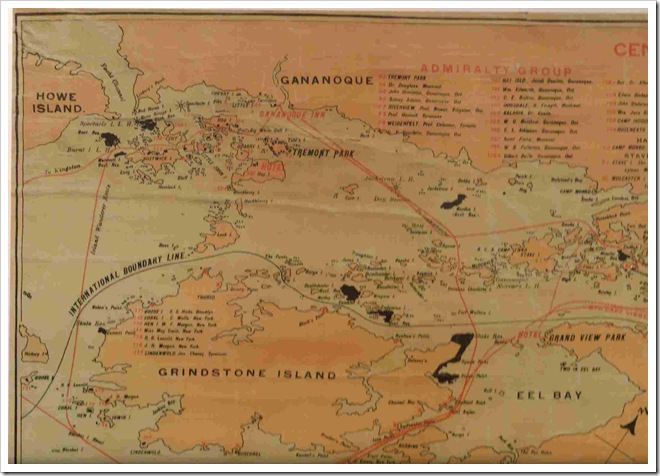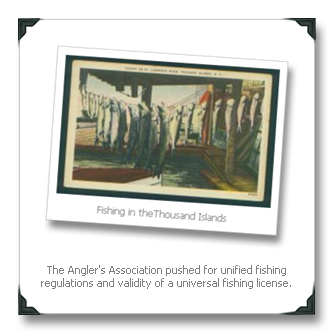Written by
Rex Ennis posted on May 13, 2009 07:31
In August of 1897, at a meeting of the New York State Fisheries, Game and Forest Commission in Albany a discussion was held on moving ahead with acquiring property for new State Parks. Under pressure from the Anglers’ Association of the St. Lawrence, a high powered group made up of such notables as Charles G. Emery, George Boldt, and W. C. Browning, several locations were suggested. The New York State Legislature had already appropriated $80,000.
 |
| |
Two commissioners, Weed and Holden along with the President of the Commission, Barnet H. Doins, inspected the properties and began negotiations with property owners. The prices seemed high, remember this was the Golden Age in the Islands, the commission felt that the owners were combining to “force an exorbitant purchase price on the state.” The Commission was anxious to move ahead with the parks as the Canadians had already purchased several properties on their side of the border. The idea being promoted by the Angler’s Association was an International Park, similar to one formed in Niagara Falls.
A state reservation was established by the state legislature in May 1896, the area was “All that part of the St. Lawrence, lying and being within the state of New York, with islands therein, is hereby constituted an international park which shall be known as ‘The state reservation of the St. Lawrence.’” The Angler’s Association’s dream of an international park was some twenty years old. Numerous meetings between New York State and Canadian government officials had been encouraged by the Angler’s Association. Although no truly international park was ever created both the Canadian Government and the State did establish many island parks.
The properties under consideration, on the New York side, for the international park or state reservations, as they were called then, were Mary’s Island off Westminster Park, DeWolf Point in the Lake of the Isles, one-half of Cedar Island, Kring Point, and Canoe and Cement Points on Grindstone Island. The commission felt that the asking prices were too high and it might “acquire the lands by condemnation.” Finally in 1898, sales were completed according to the Watertown Daily Times of 16 May 1898, as follows:
- Mary’s Island $5,000
- Canoe Point, 70 acres $4,200
- Cedar Island, 15 acres $8,000
- Kring Point, 32 acres $2,300
- DeWolf’s Point, 10 acres $ 500
- Cement Point, 3 acres $ 500
This report was printed in several newspapers at the time and maps were printed showing all the purchased properties as “State Reservations.” But what happened with Cement Point on the head Grindstone Island? Although reported in the news that Cement Point was purchased by the state and identified as state property on some maps, a check at the Jefferson County Clerk’s office shows that all the rest of the properties were purchased, but Cement Point was not. The Lowville Journal Republican reported on 14 July 1898 that commissioner Weed said that the commission had hesitated in purchasing Cement Point “because, it is said, there is not a clear title.”

The Angler’s Association pushed for unified fishing regulations and validity of a universal fishing license. An informal agreement between Canada and New York between 1893 and 1915 allowed anglers to fish on both sides of the border without a fee between Kingston and Brockville. This came to an end in 1915 when Canada imposed a $2.00 fee for fishermen with a Canadian guide and boat, a $5.00 fee for fishermen with a “foreign” boat and guide.
In 1904, the Syracuse Post Standard reported that Charles Bohlen of Philadelphia would occupy his “magnificently furnished cottage on Cement Point on Grindstone Island” for the first time that summer. An interesting incident put Cement Point in the news again when in 1916, two escaped German internees, Wiley and Erwin Prubacher, from Fort Henry in Kingston ditched their stolen skiff on Cement Point. They were caught is Clayton and returned to Kingston where they insisted that the skiff be returned to its owner!
Copyright 2009 Rexford M. Ennis, All rights reserved
Bibliography
- Lowville Journal Republican, 14 July 1898, Page 1
- The Herald, Potsdam, NY, 4 February 1898 page 1, 20 May 1898 and 18 August 1897
- Ogdensburg News, May 1898 and 27 August 1916, Page 1
- Watertown Herald, 21 May 1898
- Syracuse Post Standard, 2 Aug. 1902, 5 June 1904, Page 1
- Watertown Daily Times, 2 Dec. 1915, 8 Aug. 1895, 8 Jun. 1895, 16 May 1898, 9 March 1897, 10 May 1897, 10 Feb. 1905, and 29 May 1928, Page 9
- Rochester Democrat and Chronicle, 15 May 1896
- Utica Weekly Herald, 13 Aug. 1895, and 9 Feb. 1897
Editor's Note: Be sure to also review "The Vision of the Anglers' Association of the St. Lawrence River" written by Paul Malo and posted September 2006.
Rex Ennis is a regular contributor to TI Life from Grindstone Island. Rex is an appreciated volunteer at the Thousand Islands Museum in Clayton, NY. Please review THE PLACE/History for additional material presented by Rex.